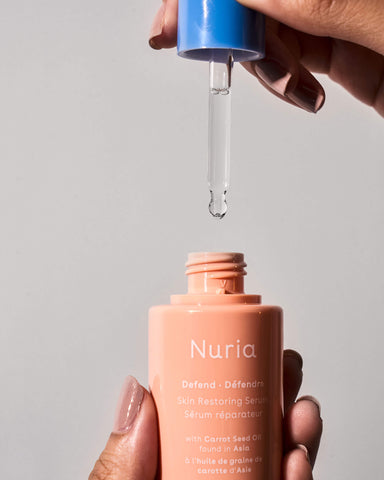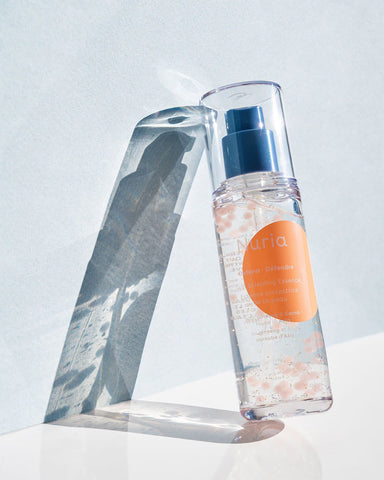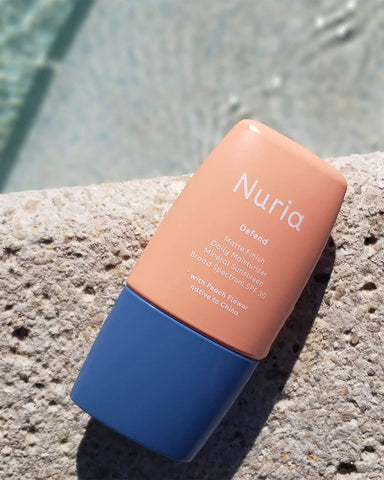
Exposome 101
Fuse the words, “expose” and “genome” and we get “exposome”: the scientific study of what happens to our body over a lifetime of exposure (unhealthy stressors from our environment). Some common types include relationships, smartphone radiation, and air quality — all which can influence genetic traits like our immunity to disease, tolerance to toxins, and resistance to signs of aging.
Thanks to exposome research, cosmetic scientists are developing groundbreaking skincare formulas to block threats to our health and beauty goals. A team of dermatological researchers based in Spain, lead by Dr. Concepcion Parrado, explore the role of exposome on skin aging.
Understanding our DNA
For starters, exposome is a DNA-focused conversation, so let’s begin there. It’s helpful to think of our DNA as a blueprint, a set of instructions that control cellular function. This genetic material is what creates the genome. We have billions of cells, each with its own genome.
Now here’s where things get interesting: every cell also has an epigenome (the genome’s boss and fortune teller…more on this shortly). The epigenome is responsible for the process whereby our genes react to our environment.
How exposome works
Environmental factors that influence skin aging fall into the following major categories: sun radiation, air pollution, tobacco smoke, diet, social experiences, and cosmetics. Based on the degree of our exposure, as Dr. Parrado explains, our bodies may respond to these elements by getting messages from the epigenetic strands in our DNA.
Epigenetics & the environment
Not all our genes will respond to exposure. Keep in mind that each cell in our body has upwards of 20,000 genes! Only a fraction of them get “expressed,” meaning the gene exists but doesn't “show up.” The epigenome decides which genetic traits stay active or deactivated — and obviously we want to keep “good genetic material” active for our skin!
Take this example: Let’s say your genetic code contains information for normal or combination skin. Then over the years, you’re exposed to high levels of stress and environmental pollutants. The epigenome processes this information and passes on a memo to your genome, saying, “Hey! Don’t let these nasty toxins penetrate our skin barrier! Let’s crank up our immune reaction (AKA redness and inflammation).” In response, your genome obeys and you develop eczema. Or in technical terms, as Dr. Parrado calls it, “ROS formation and postinflammatory gene expression.”
Exposome: genetic fate or free will?
One of the most confusing aspects of exposome is knowing the extent to which we’re capable of preventing “bad genes” from getting expressed. Because in a way, DNA is like a prophecy; it foretells the future of how our cells will behave.
But if we can’t change destiny and we can’t alter our DNA, how does the epigenome change its behavior?
Solving the genetic destiny puzzle
Here’s an analogy: Our DNA carries extra baggage. These suitcases have various electronic luggage tags, some of which are passed down by our parents and some we collect personally through our lives. These tags provide additional instructions that our DNA may or may not obey along its destination. Its fate depends on whether these tags turn "on” or “off,” or “dial up” or “dial down.” Our genetic baggage, however, never gets lost and never changes; it’s a permanent fixture we carry forever like the core of our DNA.
Now, imagine each of these tags as dormant volcanoes…yup, we’re changing analogies here. They all have the potential to erupt based on their exposure to the environment. But just because they exist, doesn’t mean they’ll become active. If we limit the impact of exposure, we increase the chances of preventing disastrous outcomes (for our skin).
When applying these insights to cosmetics, we may understand how to defend our skin cells from “bad genetic changes.”
Main stressors that affect exposure
Environmental factors that influence skin aging can be narrowed down to four main categories: air quality, nutrition, stress levels, and climate.
1) Air quality
The World Health Organization estimates that 9 out of 10 people breathe contaminated air.
Especially in populated urban areas, the air is filled with pollutants such as PAHs, greenhouse gasses, volatile organic compounds (VOCs), and O3.
“Although human skin acts as a biological barrier against pro-oxidative air pollutants, prolonged exposure to their high levels has been associated with aging as well as inflammatory skin conditions (AD and eczema),” Dr.Parrado says. To protect our face from exposure, anti-pollution facial treatments are becoming increasingly popular, loved for its easy apply-on-the-go style.
2) Diet & nutrition
Antioxidants need to be consumed, not just applied topically! By eating a balanced diet with vitamins, minerals, and healthy fats, our body carries these nutrients through the bloodstream, feeding our cells with oxygen.
The opposite effect happens from less healthy eating habits: too much refined sugar, processed snacks, and chemical additives. According to Dr.Parrado, these foods trigger exposure from free radicals which can change epigenetic strands—meaning we could add “bad genetic information” to our DNA. With the resulting increase in oxidative stress, an unhealthy diet may accelerate signs of aging.
3) Stress levels
High doses of the stress hormone cortisol, over time, ages our body. Although we need it to stay awake and alert, we also need healthy amounts of the relaxation hormone melatonin to feel calm or sleepy. This chemical is crucial for our sleep-wake cycle and overall mental and physical health.
By promoting deep high- sleep, melatonin helps our cells to restore their energy, preventing collagen loss. “Melatonin can also protect DNA against free radicals, not only by increasing gene expression of antioxidant enzymes, but also by regulating genes involved in the repair of damage to DNA,” says Dr.Parrado. So it’s no surprise that topical melatonin is emerging as a key ingredient in newer skin-calming and restorative treatments. Or alternatively, rather than introducing synthetic melatonin to your skin, clinical studies favor products containing the medicinal herb rooibos, like the Defend Skin Restoring Serum, because it stimulates natural melatonin.
4) Climate
Saving the most ruthless for last, UV sunlight causes approximately 80% of the exposure-related aging! Yikes. By speeding up cellular decay and triggering pigmentation, there are fewer keratinocytes and fibroblasts, which leads to atrophy and contributes to fibrosis, explains Dr. Parrado.
The Matte Defend Mineral Moisturizer defends against UV exposure with the hydrating power of Peach Flower and SPF 30. There’s also Euphrasia extract to soothe the appearance of fine lines and wrinkles for a flawless finish.
As exposome research continues to grow, it’s becoming clearer that the “secret” to beautiful skin is science. Yet it’s also a personal journey—a never-ending life-long mission to limit exposure. Ready? Start.
About the author, Jasmin Figueroa
Jasmin is an accomplished formulation scientist and skin health expert who has spent her career listening to consumers and developing products that rock. A founding member of the Nuria community, she loves traveling with her family, chilling with her friends at the beach, and will totally judge you if you don’t wear SPF.



